Farmers Weekly trials: The best kit for sowing grass under maize
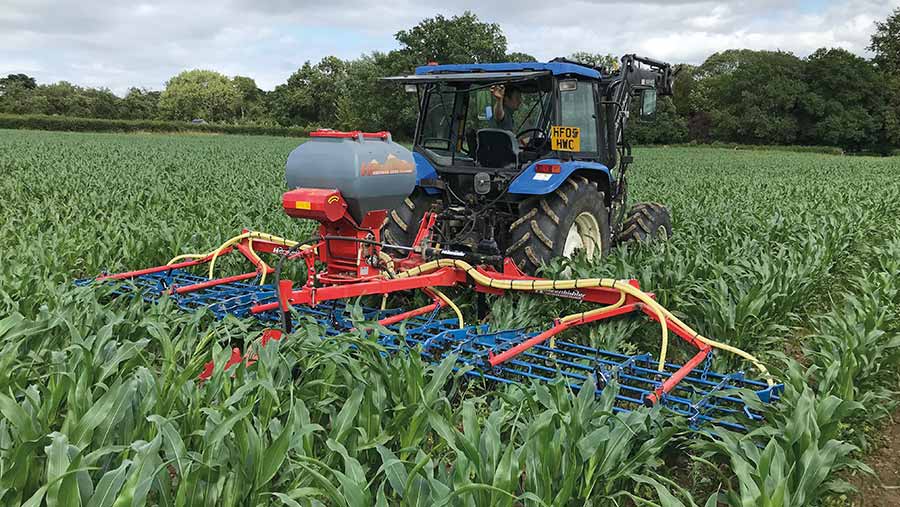 Opico harrow © Nick Fone
Opico harrow © Nick Fone Last season, Farmers Weekly joined forces with Wessex Water and Pearce Seeds to trial different ways of establishing undersown grass in crops of maize.
Water companies are keen to encourage the practice of growing catch crops in maize because it can significantly limit nitrate (and other nutrient) leaching and run-off into watercourses, thereby reducing the burden on water treatment plants.
Growers across the UK have been sowing green covers after harvest to limit run-off for decades, but when it comes to limiting nutrient leaching and pollution, it isn’t generally as effective as it needs to be.
See also: Undersowing maize: Trials, tips and all you need to know
Typically, nitrate leaching from a maize stubble left bare over winter has been found to be about 86kg nitrogen (N)/ha.
Drilling a cover crop of grass immediately behind the forager reduces this by approximately one-third to something in the region of 60kg N/ha.
While this helps, it can be bettered. Sowing a catch crop between the rows of standing maize can significantly improve nitrogen capture, reducing nitrate leaching to 31kg N/ha – a 64% reduction.
However, there is a cost to doing the job. You can factor in between £30-£85/ha for the actual operation depending on the chosen sowing method, and seed costs vary depending on the rate, but it would be fair to assume £30-£50/ha for an Italian ryegrass applied at 10-20kg/ha.
Interestingly, seed rates and costs are higher for post-harvest, autumn-sown catch crops. Typically they will need to go on at 30-40kg/ha, so the expenditure on seed can be closer to £100/ha.
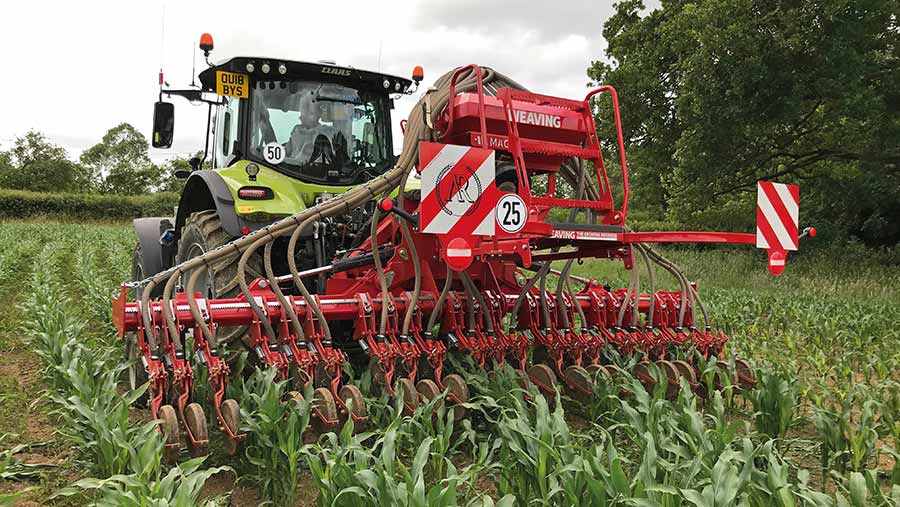
The Weaving Inter-Row drill uses direct-drill-style disc coulters with individual rubber press wheels © Nick Fone
What are the benefits?
At the most basic level there are financial gains to be had from undersowing into a growing crop of maize.
Research conducted by Wessex Water has shown that, in the following spring, undersown ryegrass contains on average 30kg N/ha, 5kg phosphorus (P)/ha and 47kg potassium (K)/ha.
And that’s just what’s above ground – take into account the root mass and you are likely to see those figures grow significantly.
Working on that basis, fertiliser regimes for the following crop can be adjusted accordingly.
But it’s not all about savings. Growers in some drinking water catchments are eligible for grants if they are prepared to undersow their maize with catch crops.
These can range from £40/ha to £120/ha, often dependent on the potential amount of nitrogen captured (calculated by some clever software).
Some water companies also offer a lesser payment – typically about £30/ha – for cover crops sown after harvest.
The other benefits are much less tangible. Having a green carpet of grass among the standing maize means both forager and trailers can travel more easily at harvest and are less inclined to drag mess out onto the road.
The other benefits are much less tangible. Having a green carpet of grass among the standing maize means both forager and trailers can travel more easily at harvest and are less inclined to drag mess out onto the road.
The soil’s improved resilience to withstanding damage from heavy kit is another big bonus, helping to maintain structure and reduce the need for remedial compaction alleviation.
Undersowing into the growing crop rather than post-harvest drilling also means there is much less likelihood of getting caught out by the weather and having to “muddle it in” late in the season.
Critically, the root structure of an early-established catch crop goes a long way in holding back topsoil erosion and run-off. The soil is, after all, farmers’ biggest and most undervalued asset.
Although not necessarily a practical proposition for establishing a mowing ley, an overwintered catch crop can provide early spring grazing for livestock.
Even if that’s not the chosen route, the biomass produced will help add to soil organic matter, and improve soil structure and workability, as well as the obvious benefit of reducing fertiliser inputs for the following crop.
There is also the looming threat that upcoming legislation will make these practices mandatory for maize growers, as has happened across various parts of Europe.
In addition, the changes to subsidy payments and the Countryside Stewardship scheme are likely to see more catch cropping encouraged, although the exact details of how this will pan out are yet to be confirmed.
While there has been much publicity around the benefits of getting a green cover established in maize, it’s not clear what the best route to doing this is. To try to clarify the issue, we compared three different means of getting a catch crop growing.
The trial
Our trials took place in south Somerset across a 4ha field of forage maize drilled in late April last year. The intention was never for this to be a true fully replicated scientific trial – more a field-scale demonstration of what is possible.
Originally, the plan was to compare grass establishment behind six or seven different machines.
Then Covid-19 struck and getting all the kit on site at the right time became impractical, so we downsized our ambitions, resulting in the three implements mentioned above.
Inter-row hoe and seeder
Capital cost: £30,000-£50,000
The subject of reducing pesticide inputs, accompanied by growing herbicide resistance issues, couldn’t be more topical.
To that end, many maize growers are looking to other methods of weed control and the key tool in this battle seems to be the inter-row hoe.
They are available in all sorts of shapes, sizes and specifications, though, ideally, their working width should match that of the drill.
A basic eight-row unit will set you back £30,000, but start adding clever camera-guided steering and applicators and you can expect to see that figure climb closer to £50,000.
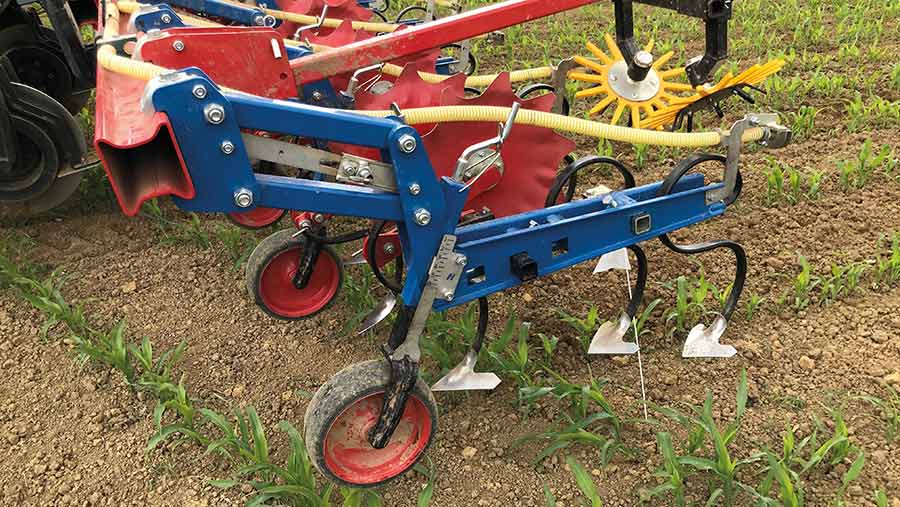
Individual parallelogram linkages and depth wheels on the Opico hoe allow for contouring, while A-shares skim the surface to flick out weed seedlings © Nick Fone
That’s the case for the machine we were loaned by Hatzenbichler importer Opico.
Equipped with the latest twin camera steering toolbar and seeder, it can even be fitted with auto section control that lifts the individual weeding units out of work as they reach the end of a bout, avoiding unintentionally hooking out crop plants on angled headlands.
There are crop shields to limit soil throw and, in addition, operators can opt for plastic finger wheel weeders that flick out weeds between the plants in the crop rows.
Grass harrow and seeder
Capital cost: £6,000-£10,000
Virtually every farm growing grass in the UK will already have access to a tine harrow. Throw a seeder into the mix and you have a relatively low-cost cover crop establishment tool.
The modifications to turn it into a machine capable of working in row crops are fairly straightforward. We started with repositioning the seeder outlets to distribute seed under the tine frames.
We then removed enough tines to allow for 15cm of undisturbed soil surface either side of each crop row and angled the lower plate on every seed outlet downwards to narrow the throw of seed to a 45cm-wide band.
This is the critical part, as plenty of research shows there will be no detrimental effect on maize yield as long as the cover crop does not establish within 15cm of the crop row (when sown after the maize reaches the six-leaf stage).
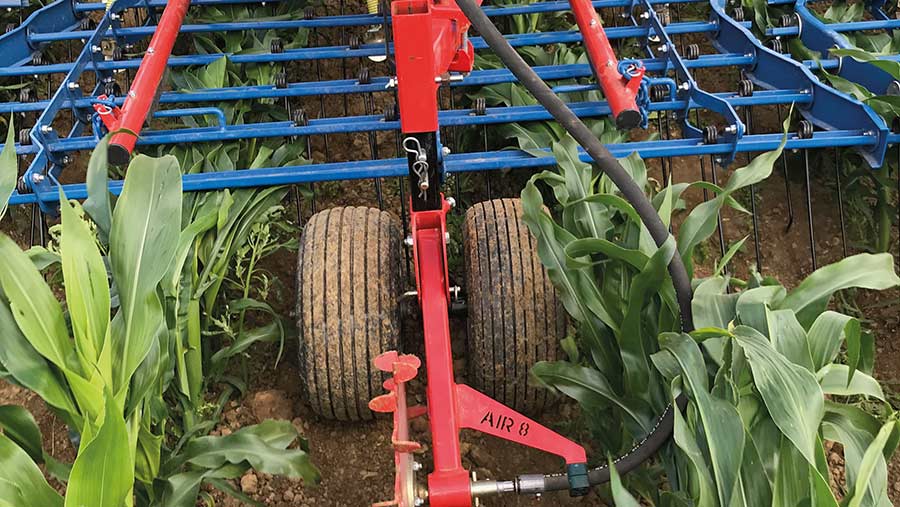
We added a pair of press wheels running in the harrow’s parking stand bracket to assess the advantage of surface consolidation © Nick Fone
The most labour-intensive part of the job was to switch the tractor wheels to match the maize row widths.
Using a lightweight 100hp tractor makes sense in limiting compaction, and its already narrow tyres meant fitting row crops wasn’t necessary.
The final tweak to our trial machine involved cobbling together a brace of pneumatic tyres to run between the middle rows, enabling us to assess the effect of seed-bed consolidation on grass-establishment rates.
Fortunately, the harrow parking stand corresponded with the gap between the central rows, so we were able to fit the makeshift press wheels in its place.
To get decent underframe clearance the tines had to be set at their highest pitch, generating maximum surface disturbance.
We therefore had concerns about moisture loss, which is why we wanted to see if the press wheels had a positive effect.
Inter-row disc drill
Capital cost: £19,800
A number of growers have built their own inter-row seeding machines, but the only dedicated drill on the market is the Weaving IR.
By employing proper disc coulters (three between each crop row) to place seed into the ground and rubber press-wheels to firm the soil up behind, it delivers decent seed-to-soil contact.
It also has the added benefit of ensuring moisture retention – essential if dry weather sets in after the seed is sown (a job often done in June).
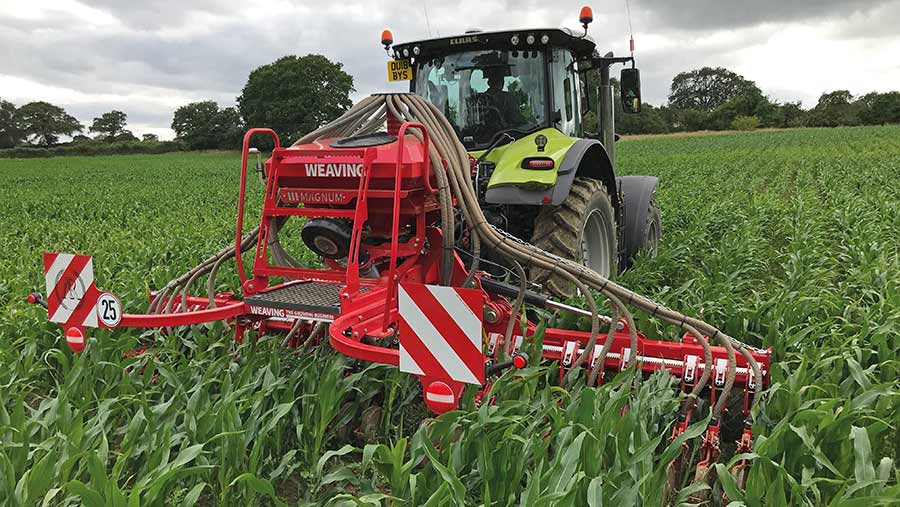
Weaving’s IR drill offers the most reliable means of getting a grass crop to grow – whatever the conditions © Nick Fone
The results |
||
|
Establishment method |
Nitrate capture (11 November 2020) |
Estimated N capture* (10 Mar 2021) |
|
Harrow and seeder |
18.4kg N/ha |
40kg N/ha |
|
Inter-row drill |
24.5kg N/ha |
67kg N/ha |
|
Hoe and seeder |
25.1kg N/ha |
41kg N/ha |
|
*Lab results weren’t available at the time of going to press, so these figures are estimated based on the amount of dry matter produced |
||
Although the differences between the drill and hoe were marginal in the autumn and the grass established by the harrow seeder combination appears to have performed worse, the reality on the ground was minimal variation in plant stands.
The Wessex Water test team suspects the lower N capture was down to a sampling anomaly rather than a reduced plant uptake in the harrowed areas.
However, the March 2021 samples showed a marked increase in the dry matter produced from the grass established behind the drill rather than that sown off the back of the harrow or hoe.
The Wessex team suspects this is due to the more consistent ground cover that the drill provided in last year’s growing conditions. This season could well prove different, though.
One of the key things this trial highlighted was the importance of working any undersowing operation around herbicide regimes.
Ideally, catch crop seed goes down between the rows when the maize is at the four- to eight-leaf stage. However, it is really important that this doesn’t disrupt the residual activity of any weed control chemicals.
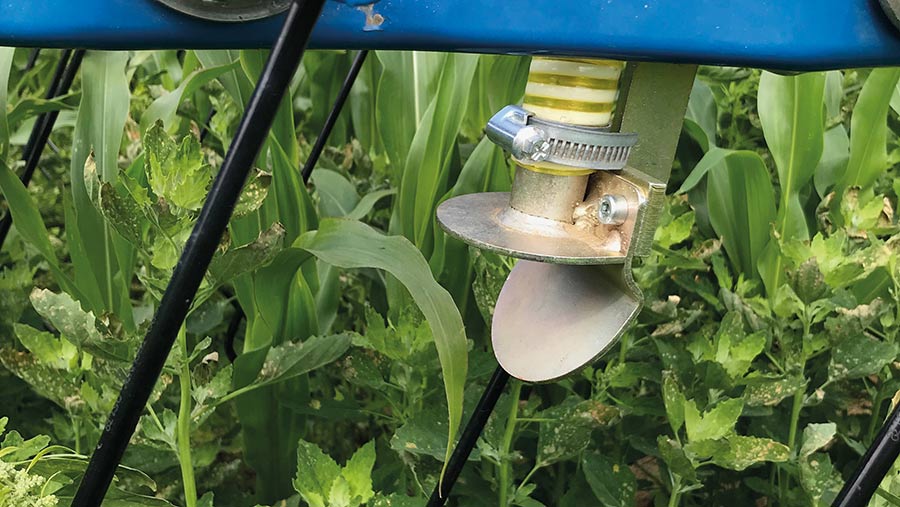
With the lower plate of the harrow seed outlet angled downwards we were able to accurately limit seed throw to a 45cm wide band between the rows of maize © Nick Fone
Our trial highlighted this. We put aside an unsprayed area as a means of comparison and gave each machine a run through this herbicide-free patch.
Across the board, grass establishment was much poorer than the rest of the field that received a single pre-emergence treatment.
We were slightly surprised, expecting to see some detrimental effect on grass emergence as a result of residual herbicide activity. But just over two weeks after the sprayer had gone in, the seeding passes seemed unaffected.
In contrast, the grass that germinated in the unsprayed area struggled to get away from the weeds, with the result that throughout the season plant populations were lower and the total biomass produced was lessened.
That would all correspond with reduced nutrient-holding capacity and a weaker root structure less able to hold back surface erosion.
In addition to this, the stronger stand of grass in the sprayed area was much better able to outcompete the weeds, with the result that, coming into spring, the stubble was much cleaner than the herbicide-free patch.
That was despite the disturbance of the soil surface by hoe, harrow and disc drill just two weeks after spraying.
FW verdict
The 2020 maize-growing season was as close to perfect as you will ever get in south Somerset. Following a dry spring, drilling was relatively easy – after that there was plenty of rain (but not too much), decent temperatures and much sunshine.
While this was great for the growing crops, it meant we were unlikely to see any differences in establishment rates between the plots sown with the different machines. In truth, pretty much anything would have grown last year.
Hoe and seeder
Planted some 10 days earlier than the rest of the field, grass sown by of the inter-row hoe didn’t take quite as well as that drilled or broadcast off the harrow.
The only likely explanation for this was that there was still some residual herbicide activity in the soil. But in the end it didn’t matter – the hoe-sown catch crop produced as much or more biomass than the rest come November.
Its big benefit is the potential it offers for reductions in herbicide use. Two or three well-timed passes could well see the need for post-emergence sprays almost done away with, especially with the in-row finger wheel weed flickers fitted.
However, it’s not cheap and multiple passes will soon see its operational costs mount up. Like the harrow, its high surface disturbance brings with it the risk of significant moisture loss and a potentially detrimental effect on catch crop establishment in a dry season.
Harrow and seeder
The harrow-sown grass took particularly well and it was surprising to see how neatly distributed the seed was within the 45cm band, hardly straying at all into the 30cm no-fly zone left for the maize.
Unsurprisingly, given the near-perfect growing conditions, our improvised press wheels didn’t generate any better emergence, although we would certainly expect to see an improvement in a dry year.
The harrow proved itself a more-than-capable undersowing tool, although it is limited by underframe clearance in taller crops. Its big advantage is that nearly every grower will probably have access to one already and it is easy to adapt for the job, so there is unlikely to be the need for a big capital outlay.
Inter-row drill
The inter-row drill performed exactly as anticipated, precisely placing seed in neat rows at a consistent depth. This resulted in more even emergence and, ultimately, resulted in more biomass produced and N captured by the spring.
Effectively, the Weaving IR is the power-harrow combination of the undersowing world – it may not be the cheapest option, but anything it sows is pretty much guaranteed to grow, even if it comes in dry after drilling.
Which is best?
These are clearly three different tools suited to different jobs. The hoe offers the opportunity to reduce chemical use and establish a green cover following its final pass of the season.
The harrow is the low-cost option that works well in a kind season, but can’t be guaranteed to produce results year-in, year-out.
If it’s a dead-cert you’re after, the inter-row drill is the answer. By accurately placing seed in the ground, it will reliably establish catch crops in standing maize in pretty much any conditions.

